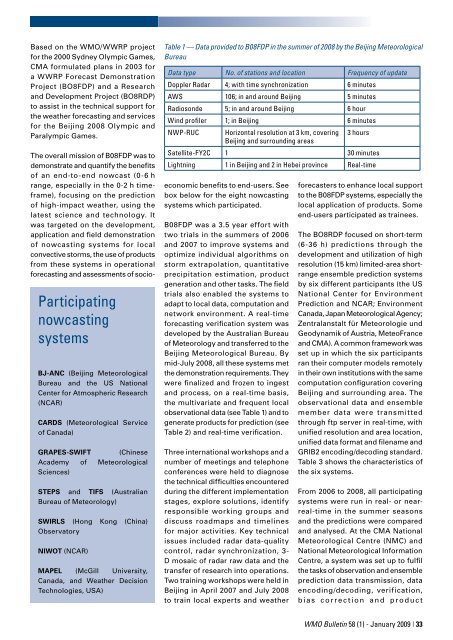Weather, climate and the air we breathe - WMO
Weather, climate and the air we breathe - WMO
Weather, climate and the air we breathe - WMO
Create successful ePaper yourself
Turn your PDF publications into a flip-book with our unique Google optimized e-Paper software.
Based on <strong>the</strong> <strong>WMO</strong>/WWRP project<br />
for <strong>the</strong> 2000 Sydney Olympic Games,<br />
CMA formulated plans in 2003 for<br />
a WWRP Forecast Demonstration<br />
Project (BO8FDP) <strong>and</strong> a Research<br />
<strong>and</strong> Development Project (BO8RDP)<br />
to assist in <strong>the</strong> technical support for<br />
<strong>the</strong> <strong>we</strong>a<strong>the</strong>r forecasting <strong>and</strong> services<br />
for <strong>the</strong> Beijing 2008 Olympic <strong>and</strong><br />
Paralympic Games.<br />
The overall mission of B08FDP was to<br />
demonstrate <strong>and</strong> quantify <strong>the</strong> benefits<br />
of an end-to-end nowcast (0-6 h<br />
range, especially in <strong>the</strong> 0-2 h timeframe),<br />
focusing on <strong>the</strong> prediction<br />
of high-impact <strong>we</strong>a<strong>the</strong>r, using <strong>the</strong><br />
latest science <strong>and</strong> technology. It<br />
was targeted on <strong>the</strong> development,<br />
application <strong>and</strong> field demonstration<br />
of nowcasting systems for local<br />
convective storms, <strong>the</strong> use of products<br />
from <strong>the</strong>se systems in operational<br />
forecasting <strong>and</strong> assessments of socio-<br />
Participating<br />
nowcasting<br />
systems<br />
BJ-ANC (Beijing Meteorological<br />
Bureau <strong>and</strong> <strong>the</strong> US National<br />
Center for Atmospheric Research<br />
(NCAR)<br />
CARDS (Meteorological Service<br />
of Canada)<br />
GRAPES-SWIFT (Chinese<br />
Academy of Meteorological<br />
Sciences)<br />
STEPS <strong>and</strong> TIFS (Australian<br />
Bureau of Meteorology)<br />
SWIRLS (Hong Kong (China)<br />
Observatory<br />
NIWOT (NCAR)<br />
MAPEL (McGill University,<br />
Canada, <strong>and</strong> <strong>Wea<strong>the</strong>r</strong> Decision<br />
Technologies, USA)<br />
Table 1 — Data provided to B08FDP in <strong>the</strong> summer of 2008 by <strong>the</strong> Beijing Meteorological<br />
Bureau<br />
Data type No. of stations <strong>and</strong> location Frequency of update<br />
Doppler Radar 4; with time synchronization 6 minutes<br />
AWS 106; in <strong>and</strong> around Beijing 5 minutes<br />
Radiosonde 5; in <strong>and</strong> around Beijing 6 hour<br />
Wind profiler 1; in Beijing 6 minutes<br />
NWP-RUC Horizontal resolution at 3 km, covering<br />
Beijing <strong>and</strong> surrounding areas<br />
3 hours<br />
Satellite-FY2C 1 30 minutes<br />
Lightning 1 in Beijing <strong>and</strong> 2 in Hebei province Real-time<br />
economic benefits to end-users. See<br />
box below for <strong>the</strong> eight nowcasting<br />
systems which participated.<br />
B08FDP was a 3.5 year effort with<br />
two trials in <strong>the</strong> summers of 2006<br />
<strong>and</strong> 2007 to improve systems <strong>and</strong><br />
optimize individual algorithms on<br />
storm extrapolation, quantitative<br />
precipitation estimation, product<br />
generation <strong>and</strong> o<strong>the</strong>r tasks. The field<br />
trials also enabled <strong>the</strong> systems to<br />
adapt to local data, computation <strong>and</strong><br />
network environment. A real-time<br />
forecasting verification system was<br />
developed by <strong>the</strong> Australian Bureau<br />
of Meteorology <strong>and</strong> transferred to <strong>the</strong><br />
Beijing Meteorological Bureau. By<br />
mid-July 2008, all <strong>the</strong>se systems met<br />
<strong>the</strong> demonstration requirements. They<br />
<strong>we</strong>re finalized <strong>and</strong> frozen to ingest<br />
<strong>and</strong> process, on a real-time basis,<br />
<strong>the</strong> multivariate <strong>and</strong> frequent local<br />
observational data (see Table 1) <strong>and</strong> to<br />
generate products for prediction (see<br />
Table 2) <strong>and</strong> real-time verification.<br />
Three international workshops <strong>and</strong> a<br />
number of meetings <strong>and</strong> telephone<br />
conferences <strong>we</strong>re held to diagnose<br />
<strong>the</strong> technical difficulties encountered<br />
during <strong>the</strong> different implementation<br />
stages, explore solutions, identify<br />
responsible working groups <strong>and</strong><br />
discuss roadmaps <strong>and</strong> timelines<br />
for major activities. Key technical<br />
issues included radar data-quality<br />
control, radar synchronization, 3-<br />
D mosaic of radar raw data <strong>and</strong> <strong>the</strong><br />
transfer of research into operations.<br />
Two training workshops <strong>we</strong>re held in<br />
Beijing in April 2007 <strong>and</strong> July 2008<br />
to train local experts <strong>and</strong> <strong>we</strong>a<strong>the</strong>r<br />
forecasters to enhance local support<br />
to <strong>the</strong> B08FDP systems, especially <strong>the</strong><br />
local application of products. Some<br />
end-users participated as trainees.<br />
The BO8RDP focused on short-term<br />
(6-36 h) predictions through <strong>the</strong><br />
development <strong>and</strong> utilization of high<br />
resolution (15 km) limited-area shortrange<br />
ensemble prediction systems<br />
by six different participants (<strong>the</strong> US<br />
National Center for Environment<br />
Prediction <strong>and</strong> NCAR; Environment<br />
Canada, Japan Meteorological Agency;<br />
Zentralanstalt für Meteorologie und<br />
Geodynamik of Austria, MeteoFrance<br />
<strong>and</strong> CMA). A common framework was<br />
set up in which <strong>the</strong> six participants<br />
ran <strong>the</strong>ir computer models remotely<br />
in <strong>the</strong>ir own institutions with <strong>the</strong> same<br />
computation configuration covering<br />
Beijing <strong>and</strong> surrounding area. The<br />
observational data <strong>and</strong> ensemble<br />
member data <strong>we</strong>re transmitted<br />
through ftp server in real-time, with<br />
unified resolution <strong>and</strong> area location,<br />
unified data format <strong>and</strong> filename <strong>and</strong><br />
GRIB2 encoding/decoding st<strong>and</strong>ard.<br />
Table 3 shows <strong>the</strong> characteristics of<br />
<strong>the</strong> six systems.<br />
From 2006 to 2008, all participating<br />
systems <strong>we</strong>re run in real- or nearreal-time<br />
in <strong>the</strong> summer seasons<br />
<strong>and</strong> <strong>the</strong> predictions <strong>we</strong>re compared<br />
<strong>and</strong> analysed. At <strong>the</strong> CMA National<br />
Meteorological Centre (NMC) <strong>and</strong><br />
National Meteorological Information<br />
Centre, a system was set up to fulfil<br />
<strong>the</strong> tasks of observation <strong>and</strong> ensemble<br />
prediction data transmission, data<br />
encoding/decoding, verification,<br />
bias correction <strong>and</strong> product<br />
<strong>WMO</strong> Bulletin 58 (1) - January 2009 |

















